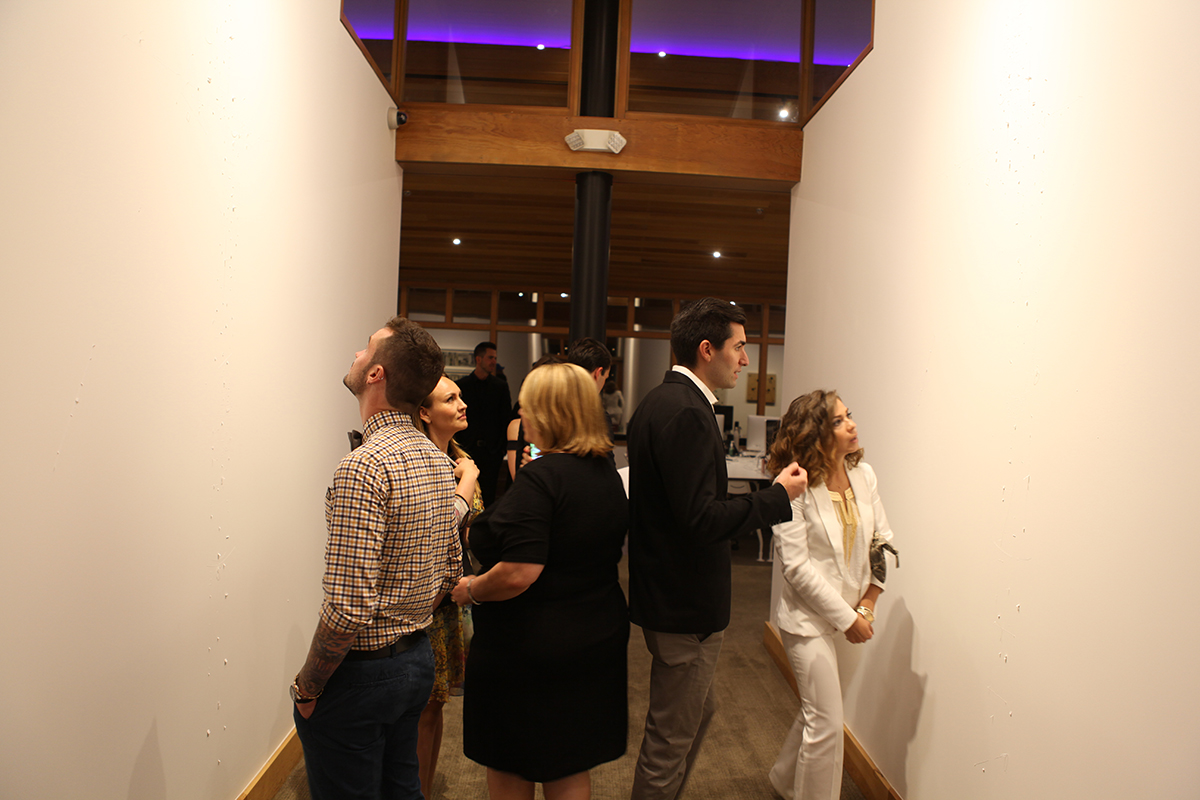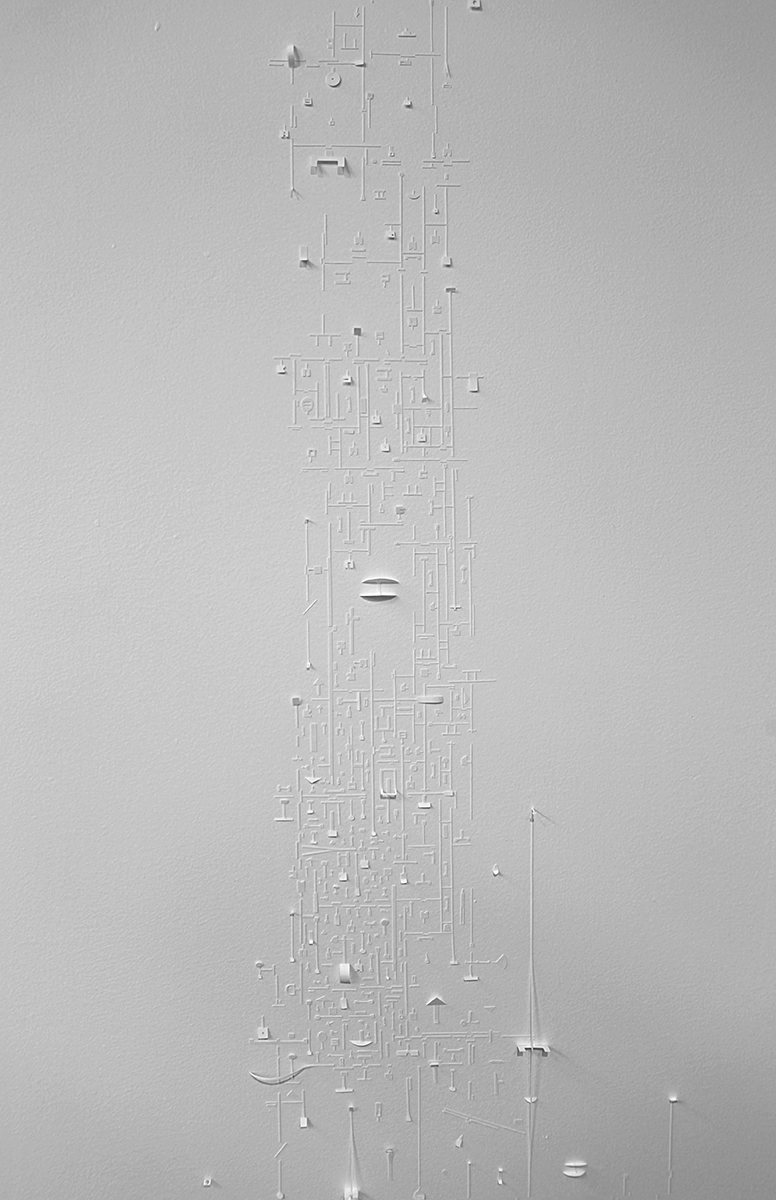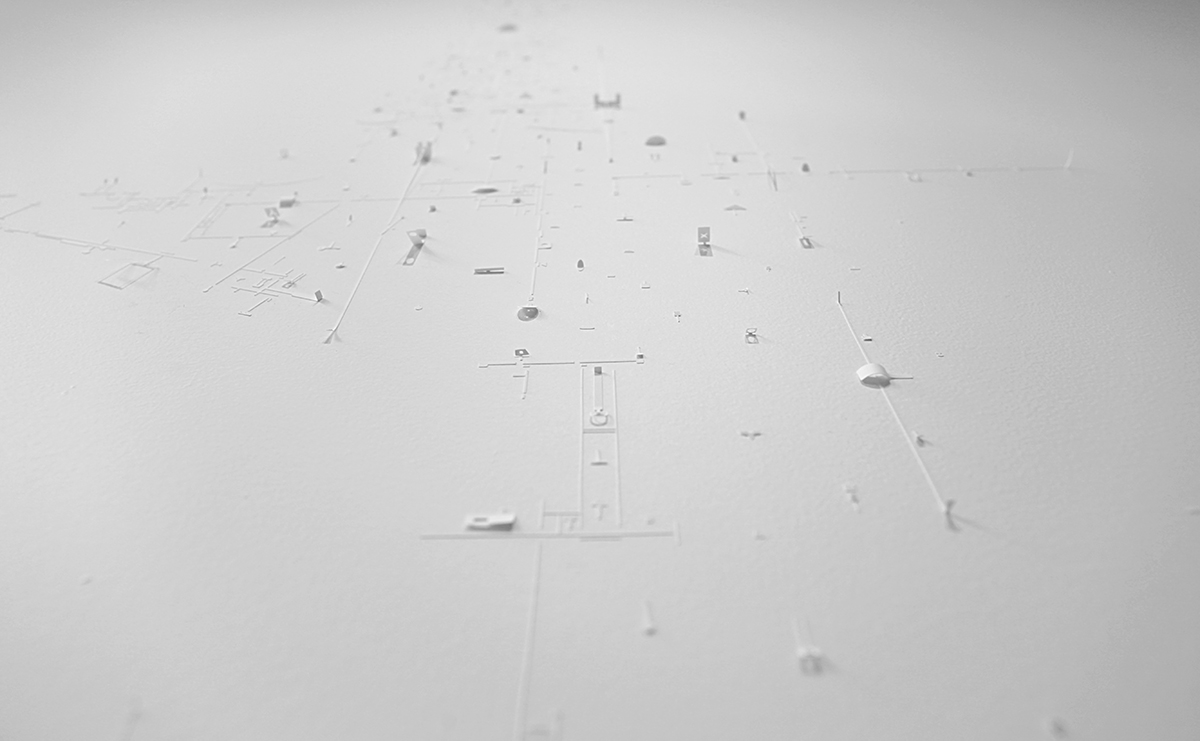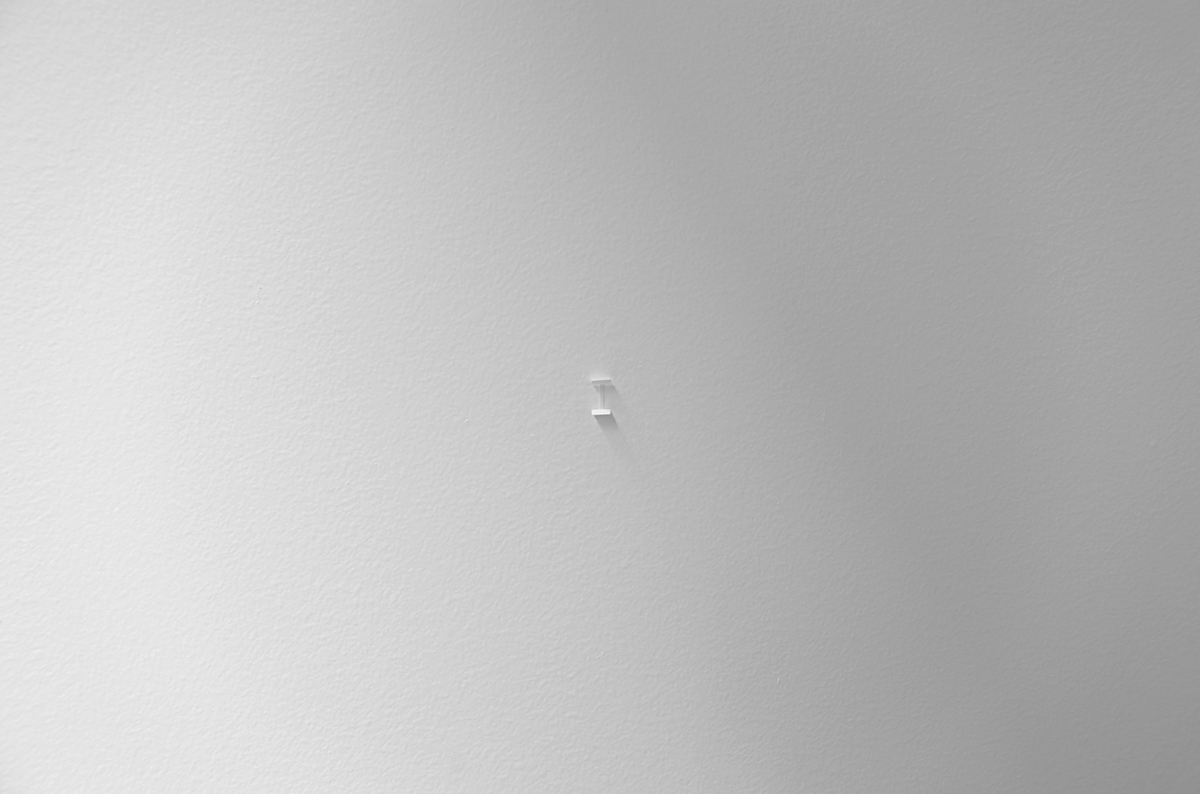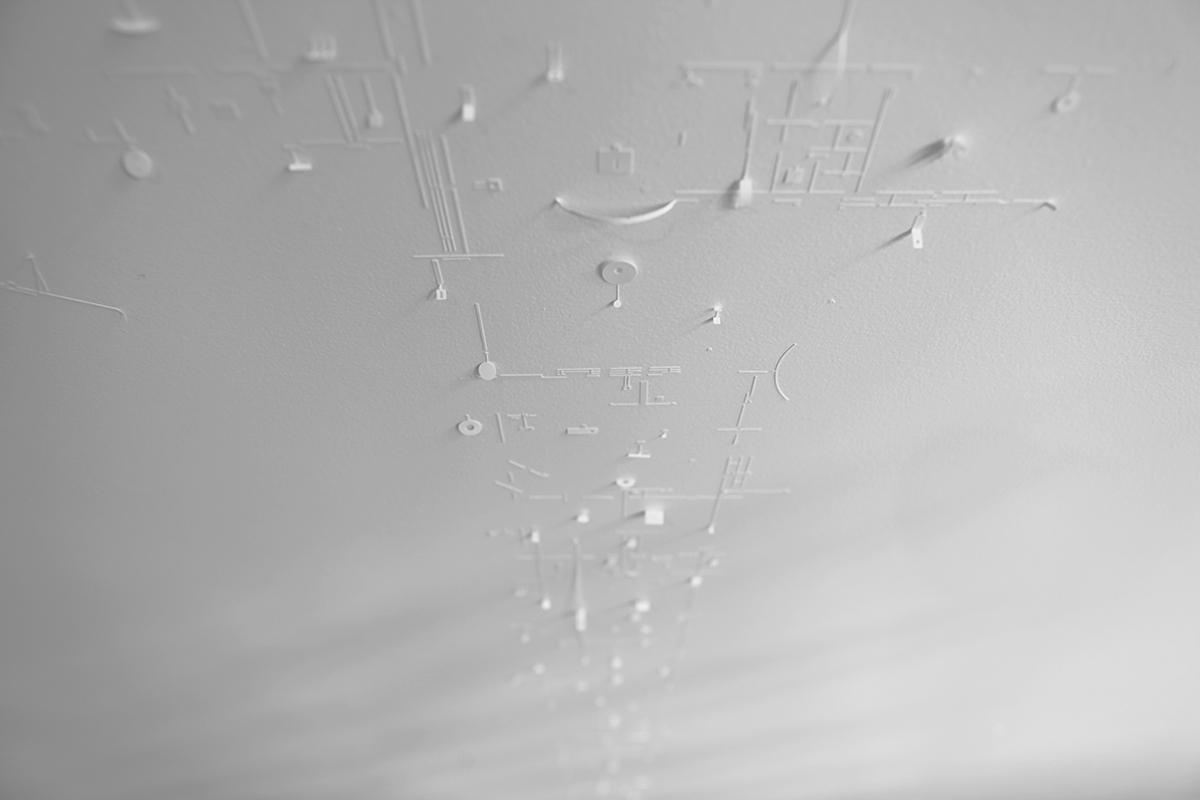June 13, 2015 – April 1, 2016
SPACE, Irvine, CA
The Sayago & Pardon Collection is proud to present Into Whiter Space, a project of Abstraction in Action. Marco Maggi’s Into Whiter Space, 2015isa site-specific installation at SPACE, Sayago & Pardon’s headquarters located in Irvine, California. Into Whiter Space was produced in the context of the exhibition Monochrome Undone, opening atSPACE October 24, 2015.
Into Whiter Space alludes to the purist and conclusive modern idea of a uniform white painterly surface of the monochrome. The piece is proposed as a sort of textured and irregular, but delicate, skin on two large facing walls. These walls are intervened with hundreds of small white stickers cut in different shapes. The artist comments: “…around them [are] more and more stickers, like growing towns to build a big city [L.A.?] or adding letters, sentences, paragraphs, chapters to write a novel. Homeopathic process, constructing or demolishing syntax.”
The artist aims not only for us to slow down, but to lose our daily sense of purpose while observing the work. Our eyes make sense of the world through the interaction of the focal and the peripheral visions. Whereas the focal allows us to focus on details and represents our conscious vision, the peripheral helps us to organize space and encompass shadow to create context. Through one pragmatic act of seeing, Marco Maggi’s Into Whiter Space can neither be apprehended in its totality, nor its many details. The complex, structured, yet unpredictable surface challenges a deliberate single-minded gaze for us to discover a freer, slower, and broader way of seeing. Maggi’s monochrome does not function as a blank purified space of order and control; instead it is paradoxically unsubordinated and it denaturalizes the conceptual neutrality associated to white. Time slows down and totality is not possible. Into Whiter Space will have a second life, as a digital platform on Abstraction in Action. The Internet will provide an intimate experience allowing the particularities of every cutout to be explored in detail while the whole still remains elusive.
—
Into Whiter Space alude a la idea purista, moderna y concluyente de la superficie pictórica blanca y uniforme del monocromo. La pieza se propone como una especie de piel texturizada, irregular, sobre dos grandes muros contiguos. Estas paredes se intervinieron con cientos de pequeñas calcomanías blancas cortadas en diferentes formas. El artista comenta: “…alrededor de ellos [son] más y más calcomanías, como ciudades en crecimiento construyendo una gran ciudad [¿Los Ángeles?] o agregando letras, oraciones, párrafos, capítulos para escribir una novela. Proceso homeopático, construyendo o destruyendo sintaxis.”
El artista tiene como objetivo no sólo que nos detengamos, sino que perdamos nuestro sentido del propósito diario al observar su obra. Nuestros ojos hacen sentido del mundo a través de la interacción entre las visiones periféricas y focales. Mientras que la visión focal nos permite centrarnos en detalles ya que representa nuestra visión consciente, la visión periférica nos ayuda a organizar el espacio y abarca sombra para crear contexto. A través del acto pragmático de ver, Into Whiter Space no puede ser aprehendida en su totalidad ni en sus muchos detalles. La superficie compleja, estructurada y, aún así, impredecible, desafía la mirada inquebrantable con el propósito de descubrir de una manera más libre, más lenta y más amplia del acto de ver. El monocromo de Maggi no funciona como un espacio blanco, puro, en orden y control, por el contrario, es paradójicamente insubordinado y desnaturaliza la neutralidad conceptual asociada a lo blanco. El tiempo se torna lento y la totalidad deja de ser posible. Into Whiter Space tendrá una segunda vida en la plataforma digital de Abstraction in Action. El Internet proporcionará una experiencia íntima permitiendo que las particularidades de cada recorte se exploren en detalle, mientras que el conjunto seguirá siendo elusivo.
—
Interview with Marco Maggi
Cecilia Fajardo-Hill: Where and how did the idea to construct surfaces with sticky white tags originate?
Marco Maggi: Letterpress: transferable letters very common before computation revolutionized graphic design. I never thought of tags or stickers: I began with the image of self-adhesive alphabets. The objective was to have a medium capable of editing a wall by disseminating thousands of independent and unintelligible particles.
I looked for a ceramic paper free of acid and I found an archival form of making it self-adhesive. I began increasing control over the sticking and folding of little papers until I was able to reduce the scale of my cuts to a visual whisper or insignificant text.
The resulting landscape appears like an incubator of language, or the complete opposite… segments of castaways from the dictionary.
The message lost it’s meaning toward the end of the seventies and in reality 95% of the present description of the universe is made through mathematical metaphors. The words loose footing in the contemporary discourse and uncertainty has no one who will write of it. Drawing is the only way to think without letters or numbers… indeed this is what the particles on the translucent boards of Letterpress were.
CF-H: How does this new facet of your work relate and diverge from your previous work, like the intervened slides or the aluminum foil?
MM: I work with surface tensions in different materials seeking to approach and stop the observer. An invitation for a change of protocol: reduce distance and velocity, two largely present illnesses. In synthesis, the promotion of pauses and approaches connects all of my works. The surface and calligraphy that each one generates may change, but all of my drawings seek to make time visible and to establish an objective intimacy.
CF-H: It would appear that the tags give you the possibility of expanding your work in space, something that I have not seen before in your work, that only amplified itself into larger formats through the multiplication of slides. What new possibilities does it offer you to work spatially? Is working in space something that you were pursuing or did it happen in a ‘natural’ way?
MM: Each show is and was a great drawing that edits the space with seasons or elements. Before they were stacked paper on the floor, frames, panels, slide stacks, shelves on the wall, etc. I always face each room like an itinerary: a great folded sheet on the walls-ceiling-floor where the works complete the function of paragraphs of text.
Now with thousands of self-adhesive elements, the dialog with the space has been made more intense and notable because it permits the inclusion of the observer in the page.
CF-H: The Uruguay Pavilion at the Venice Biennial is the most ambitious and laborious work that you have realized to this date. What experience does working at this scale offer you?
MM: I began training in the preceding months. I knew that the sum of the walls was equivalent to a sheet 40 meters long and 4 meters tall and the plan was to traverse it over months from the verticality of the ladder to the horizontality of the base.
After occupying myself with the health of each inch of the Pavilion, the most surprising result was the profound relationship with the building. When Uruguay bought it in 1960 it was the tool storage room for the gardens of the Biennial; today it is a humble and surprising testament to the squandering of resources that surrounds these events.
CF-H: How do you conceive of these surfaces covered with tags in different formats: wall, paper, large or small? How does their nature change by being constrained by a frame or by being atomized on a wall?
MM: It is like comparing a novel with a short story. The objective, vocabulary and syntax remain the same, but the structure of the tale needs to respond to its scale. In the wall installation, first that which is tree-like, the fragility and the expiration date.
The frames have to function like windows onto a second reality and not like cages to preserve a Bonsai wall.
The essentials in a framed drawing are the escape attempts, the lines of flight. A frame should be faced like a portable infinity.
To read the walls of a room allows the observer to walk, to select their itinerary and their rhythm.
A framed drawing allows exactly the same for the gaze. The rules of transit are similar and the discretion is identical: when entering the room appears empty, when looking at a framed drawing from a distance the information is erased.
In a room time depends on space, in a frame the space depends on time…two different relationships that generate complementary experiences.
If one examines a sheet of paper with great attention one discovers more space and diversity than flying quickly over the Sahara desert. The space always depends on some information that stimulates one to slow down and the capacity of the observer to stop and excavate the visual field.
CF-H: What role does light play in these white surfaces? In Venice the light that you installed was very white and clean, while in SPACE, the light is much more complex and changing, due to the intervention of exterior light that changes during the day, the light of the work areas, and the light of the installation itself. What happens with your work in these very different circumstances?
MM: The illumination in Venice is perfect for my work. An even field of light that generates shadows and high definition projections. It is a technology that had been never seen before 2014, which combines the softness of a wall washer with the hardness of a halogen reflector. The key is that they are light projectors and not reflectors. For that reason the walls of the Pavilion appear to illuminate instead of being illuminated.
In SPACE all of the work is playing off of the permeability of the context. Everything happens between a large office and a garden that incorporates the light of the sun or the shadows of a single tree. The extremely vertical light bulbs create a rain of light in a region where it barely rains.
CF-H: One of the aims of your work is to reduce the speed of our daily lives and create an interruption that promotes observation without purpose. How do you achieve this with a work that is invisible at first?
MM: In front of that which is spectacular and rotund, one step backward, creating distance. The spectacular is short, intense, distant and repetitive in the reactions it provokes.
That which does not seek to impact, does not exist until it is discovered and it is capable of creating empathy, attention, dialog and diversity in responses. The discrete embodies.
The opposite of a shock is a blank pause… it is like buying an overdose of information with a coat rack. When reality made itself illegible, visual arts preferred to become invisible.
CF-H: Your installation in Venice is called Global Myopia and the installation in SPACE is called Into Whiter Space. Both titles allude to an un-drawing of the concrete and the visible on a global scale or in the space. And yet, these works allude to an act of seeing, to loose oneself in the detail, to find intimacy in an abstract space. Can you speak about this conceptual aspect of myopia and white space?
MM: I like precise confusions and slow scandals. One reads “Global Myopia” and thinks of a near-sighted world that walks toward its grave.
However, the title Global Myopia is a prescription and not an accusation. It is an elegy to the myopia that suggests that we globally adopt a protocol or gesturality of the near-sighted. All near-sighted people see better than anyone by stopping and getting close to what one observes.
After a farsighted twentieth century, capable of engendering “solutions” for everyone and forever, we deserve a XXI century less pretentious and focused on those who are in our proximity and that which is in our proximity (proximity of closeness).
After so many definite certainties we should partake in a sensible digression, doubtful and precarious.
The white? There is nothing more uncertain than white over white. Without any contrast it has an infinite amount of information that is rendered imperceptible with out the attention and participation of the other. The information stuck to the wall, on the threshold between 2 and 3 dimensions, does not interfere with the landscape; it flattens like illiterate ivy.
CF-H: We have spoken about the role that focal and peripheral sight plays in the act of looking at your work, since your work does not allow us to see everything, just details, and at the same time it exists and has sense in only in totality. Could we think of your work as a totality in fragmentation, like a sort of archeology of a totality? How do you imagine and propose the act of seeing in an installation like Into Whiter Space?
MM: The ideal would be not to go specifically to see it but to cross this landscape naturally until one finally detects a vibration in the surface of the wall… a faint shadow of the point of a thread. And from the first little paper that one finds one traverses the network of particles, creating a unique itinerary.
With Into Whiter Space, one cannot read its two chapters at the same time; they are two walls or pages in confrontation (hemistich). Only with much attention can one discover one and another wall in alternating form that the structures are almost identical like a reflection in paper.
The work includes various strategies to retain the observer such as scale and dispersion, with the illusion of multiplying empathy for the insignificant.
When someone has something very clear to communicate, one orders, synthesizes and designs one’s message. One imposes an angle of reading on the receiver and one distributes it as quickly as possible. These parameters of communication are ones shared by news agencies, advertising and conceptual art. Brilliant ideas, magic products or brave accusations, and edited to urgently infect the other.
In my case, the exact opposite happens… since I don’t have anything to say, my process is slow because there is no rush to communicate the result. Its reading is entirely free, delayed, partial and barely possible.
It deals with installing an inclusive and infinitesimal landscape based on an elusive dissemination.
I have no ideas and the ones I include in this response have an expiration date. When I read them again I will consider them junk from a drawing or ideology of the draughtsman.
I have never regretted what I have drawn… I don’t use an eraser. I always regret what I say. I am a radical optimist and for this reason I continue to answer.
CF-H: White is linked with the ideal color of modernism with its ordered and utopian associations. What is the place that the color white occupies in your work and in this installation in particular?
MM: White on white is the most radical camouflage; it is the manifest intention of erasing itself. There is nothing less graphic and emphasized than a polar bear. Erasing me, visual arts on the threshold of blindness.
CF-H: What does working in a space like SPACE mean, where the activity that is occurring concerns the digital world where the language, the sounds, and the energy of the place and its people have nothing to do with the art world? Did you encounter some relationship between your complex surfaces and the complexity of the digital world and data?
MM: I arrived in Irvine with a kit of thousands of little papers and I had the general structure of the drawing: stereophonic dialog between Left and Right walls.
What I did not foresee was that SPACE integrated abstraction through mathematics, art and Big Data. A building dedicated to the relationship between the micro and the macro in disciplines with such different objectives and reading processes so similar. The light, the personal climate and the horizontality of SPACE are the opposite of an impeding hierarchical pyramid. A climate of a university campus without the least need for anyone to feel like a professor. A world that has recently emerged resulting from a cultural revolution never seen before.
CF-H: What could be the analog between “Big Data” and the utopian surfaces of stickers that you created with Into Whiter Space?
MM: That relationship is intimate, surprising and in no ways utopian: macro, micro, margin.
When you order the routines attitudes, and comportments of hundreds of millions of people (Big Data) the result is not a unified and obvious chorus, but instead a cacophony that hides thousands of possible melodies or discourses.
Every specialist, confronting this mute wall, hears it by establishing connections that have never been made with the data that will permit one to define tendencies and detect predictions drowned in an ocean of information. Like a reader of a macro sky capable of isolating the micro relationship between the three Marías or the obvious orientation of the Southern Cross.
Big Data unifies homeopathic doses of information. Distant, dispersed, disseminated and discrete signs like thousands of white micro papers on a white wall.



